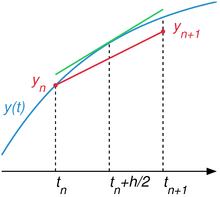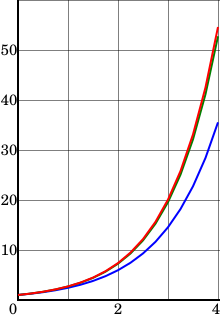
In numerical analysis, a branch of applied mathematics, the midpoint method is a one-step method for numerically solving the differential equation,
The explicit midpoint method is given by the formula
| 1e |
the implicit midpoint method by
| 1i |
for Here, is the step size — a small positive number, and is the computed approximate value of The explicit midpoint method is sometimes also known as the modified Euler method, the implicit method is the most simple collocation method, and, applied to Hamiltonian dynamics, a symplectic integrator. Note that the modified Euler method can refer to Heun's method, for further clarity see List of Runge–Kutta methods.
The name of the method comes from the fact that in the formula above, the function giving the slope of the solution is evaluated at the midpoint between at which the value of is known and at which the value of needs to be found.
A geometric interpretation may give a better intuitive understanding of the method (see figure at right). In the basic Euler's method, the tangent of the curve at is computed using . The next value is found where the tangent intersects the vertical line . However, if the second derivative is only positive between and , or only negative (as in the diagram), the curve will increasingly veer away from the tangent, leading to larger errors as increases. The diagram illustrates that the tangent at the midpoint (upper, green line segment) would most likely give a more accurate approximation of the curve in that interval. However, this midpoint tangent could not be accurately calculated because we do not know the curve (that is what is to be calculated). Instead, this tangent is estimated by using the original Euler's method to estimate the value of at the midpoint, then computing the slope of the tangent with . Finally, the improved tangent is used to calculate the value of from . This last step is represented by the red chord in the diagram. Note that the red chord is not exactly parallel to the green segment (the true tangent), due to the error in estimating the value of at the midpoint.
The local error at each step of the midpoint method is of order , giving a global error of order . Thus, while more computationally intensive than Euler's method, the midpoint method's error generally decreases faster as .
The methods are examples of a class of higher-order methods known as Runge–Kutta methods.
Derivation of the midpoint method


The midpoint method is a refinement of the Euler method
and is derived in a similar manner. The key to deriving Euler's method is the approximate equality
| 2 |
which is obtained from the slope formula
| 3 |
and keeping in mind that
For the midpoint methods, one replaces (3) with the more accurate
when instead of (2) we find
| 4 |
One cannot use this equation to find as one does not know at . The solution is then to use a Taylor series expansion exactly as if using the Euler method to solve for :
which, when plugged in (4), gives us
and the explicit midpoint method (1e).
The implicit method (1i) is obtained by approximating the value at the half step by the midpoint of the line segment from to
and thus
Inserting the approximation for results in the implicit Runge-Kutta method
which contains the implicit Euler method with step size as its first part.
Because of the time symmetry of the implicit method, all terms of even degree in of the local error cancel, so that the local error is automatically of order . Replacing the implicit with the explicit Euler method in the determination of results again in the explicit midpoint method.
See also
Notes
- Süli & Mayers 2003, p. 328
- Burden & Faires 2010, p. 286
References
- Griffiths, D. V.; Smith, I. M. (1991). Numerical methods for engineers: a programming approach. Boca Raton: CRC Press. p. 218. ISBN 0-8493-8610-1.
- Süli, Endre; Mayers, David (2003), An Introduction to Numerical Analysis, Cambridge University Press, ISBN 0-521-00794-1.
- Burden, Richard; Faires, John (2010). Numerical Analysis. Richard Stratton. p. 286. ISBN 978-0-538-73351-9.
| Numerical methods for ordinary differential equations | |
|---|---|
| First-order methods | |
| Second-order methods | |
| Higher-order methods | |
| Theory | |
 equals the exact value
equals the exact value  The midpoint method computes
The midpoint method computes  so that the red chord is approximately parallel to the tangent line at the midpoint (the green line).
so that the red chord is approximately parallel to the tangent line at the midpoint (the green line).


 Here,
Here,  is the step size — a small positive number,
is the step size — a small positive number,  and
and  giving the slope of the solution is evaluated at
giving the slope of the solution is evaluated at  the midpoint between
the midpoint between  at which the value of
at which the value of  is known and
is known and  at which the value of
at which the value of  is computed using
is computed using  . The next value
. The next value  . However, if the second derivative is only positive between
. However, if the second derivative is only positive between  . Finally, the improved tangent is used to calculate the value of
. Finally, the improved tangent is used to calculate the value of  , giving a global error of order
, giving a global error of order  . Thus, while more computationally intensive than Euler's method, the midpoint method's error generally decreases faster as
. Thus, while more computationally intensive than Euler's method, the midpoint method's error generally decreases faster as  .
.
 Blue: the
Blue: the  The step size is
The step size is 
 It is seen that the midpoint method converges faster than the Euler method.
It is seen that the midpoint method converges faster than the Euler method.





 as one does not know
as one does not know  at
at  . The solution is then to use a
. The solution is then to use a  :
:




 for
for  results in the implicit Runge-Kutta method
results in the implicit Runge-Kutta method

 as its first part.
as its first part.
 . Replacing the implicit with the explicit Euler method in the determination of
. Replacing the implicit with the explicit Euler method in the determination of  results again in the explicit midpoint method.
results again in the explicit midpoint method.